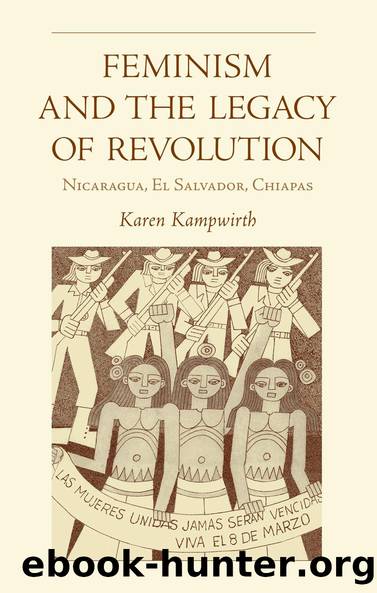Feminism and the Legacy of Revolution by Karen Kampwirth

Author:Karen Kampwirth [Kampwirth, Karen]
Language: eng
Format: epub
Tags: Social Science, Gender Studies, General, Women's Studies, Sociology, Political Science
ISBN: 9780896804401
Google: 7PNHBAAAQBAJ
Publisher: Ohio University Press
Published: 2014-07-31T04:05:23+00:00
Ramona Breaks the Blockade
Comandante Ramona, a Tzotzil woman who was deathly ill, represented the EZLN at the congress. She was the first to break the blockade with which the government had tried to restrict the EZLN, and their demands, to the periphery of the country.22 From the very beginning of the Zapatista rebellion, Ramona was a central figure. One of two women on the eleven-member ruling indigenous committee (along with Major Ana MarÃa), it was she who presented the Mexican flag, captured on the first of January 1994, at the February peace talks in the cathedral of San Cristóbal. More than any other single Zapatista woman, it was Ramona who captured the imagination of millions. This comment, made at a workshop in 1994, was typical of those I heard during my fieldwork: âHow wonderful that Ramona appeared! We think she loves us, that is why she came out to journey; it is like she is pulling us along. She shows us the path we can create, she is a great, wise personâ (Grupo de Mujeres et al. 1994, 22).
Ramona was an unlikely guerrilla: small, sickly, unthreatening; dressing not in military fatigues but in the elaborately embroidered clothing that identified her as an indigenous woman from the highlands. Perhaps for those reasons, Ramona was often spoken of in mystical, quasi-religious terms; something I never heard in the case of other Zapatista women. Ramona was said to suffer for women, suffering because she loves us so. She was even said to happily die so that others might live a better, if not eternal, life: âAmong the indigenous leaders of the rebellion there is a small woman, even small among the small people. . . . Ramona did not know it well at that time and we didnât either, but she carries in her body a sickness that consumes her life and shuts down her voice and her sight. Ramona laughed when she did not know she was dying. Now that she knows it, she continues laughing. Before nobody knew she existed; now she exists, she is a woman, an indigenous person, and a rebel. Now she lives, Ramona, a woman of that race that has to die in order to liveâ (Marcos, quoted in NCDM 1996b, 5). Tens of thousands greeted this rebel woman when she arrived in Mexico City (Hernández Navarro 1997, 87). Sending Ramona to the indigenous congress was a brilliant move; a move that made the Mexican government out to be a Goliath losing in battle to a female David, at least this time.
After breaking the government blockade on the Zapatistas and receiving lifesaving medical attention in Mexico City,23 Ramona was ready to provide the symbolic leadership for a new national movement for indigenous womenâs rights. Nearly a year after the first National Indigenous Congress, indigenous women celebrated their first national conference in August 1997 in the capital of the state of Oaxaca. Comandante Ramona inaugurated the first National Gathering of Indigenous Women (Encuentro Nacional de la Mujer IndÃgena), a gathering attended by more than four hundred women from twenty-three indigenous regions.
Download
This site does not store any files on its server. We only index and link to content provided by other sites. Please contact the content providers to delete copyright contents if any and email us, we'll remove relevant links or contents immediately.
| Belize | Costa Rica |
| El Salvador | Guatemala |
| Honduras | Nicaragua |
| Panama |
Cat's cradle by Kurt Vonnegut(13934)
Pimp by Iceberg Slim(12977)
Underground: A Human History of the Worlds Beneath Our Feet by Will Hunt(11294)
4 3 2 1: A Novel by Paul Auster(11102)
The Radium Girls by Kate Moore(10950)
American History Stories, Volume III (Yesterday's Classics) by Pratt Mara L(4834)
Perfect Rhythm by Jae(4643)
Wiseguy by Nicholas Pileggi(4633)
The Fire Next Time by James Baldwin(4375)
Paper Towns by Green John(4193)
A Higher Loyalty: Truth, Lies, and Leadership by James Comey(4061)
Pale Blue Dot by Carl Sagan(4041)
The Mayflower and the Pilgrims' New World by Nathaniel Philbrick(3930)
The Doomsday Machine by Daniel Ellsberg(3761)
Too Much and Not the Mood by Durga Chew-Bose(3711)
Killers of the Flower Moon: The Osage Murders and the Birth of the FBI by David Grann(3659)
The Borden Murders by Sarah Miller(3606)
The Sympathizer by Viet Thanh Nguyen(3547)
Killing England by Bill O'Reilly(3479)
